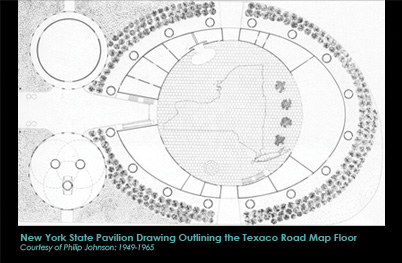
Philip Johnson received the commission for the Fair’s New York State Pavilion from Governor Nelson Rockefeller following his acclaim for the New York State Theater at Lincoln Center. Rockefeller instructed Johnson to design the largest and tallest pavilion at the fair, flaunting the state’s status as host and proving beyond a doubt that New York was a true hub for progressive art and culture. He worked with partner Richard Foster and structural engineer Lev Zetlin to design a pavilion that would showcase both architectural and technological innovation. Like most structures at the Fair, the Pavilion was originally designed to be temporary and was to be demolished after the close.

According to Johnson, his aim was to achieve “an unengaged free space as an example of the greatness of New York, rather than a warehouse full of exhibit material.” The result was a Pavilion that consisted of three elements: the main open-air structure called the “Tent of Tomorrow”, three “Astro-View” observation towers, and a circular theater known as the “Theaterama”. With less than serious references to flying saucers and a colorful circus tent, Johnson’s New York State Pavilion embodied the same pop culture references that informed the Pop Art works selected by Johnson and showcased on the walls of the Theaterama.
Although contemporary architectural historians have often overlooked this work of Johnson’s, architectural critics of the day considered the Pavilion’s innovative design worthy of praise. Highlighting its underlying spirit of fun, architectural critic Ada Louise Huxtable described the Pavilion as “a sophisticated frivolity…seriously and beautifully constructed. This is a ‘carnival’ with class.”